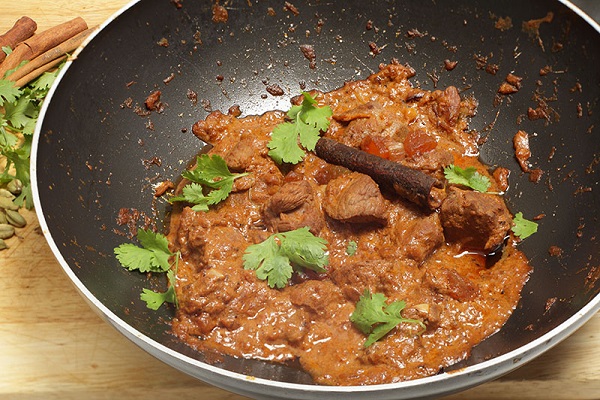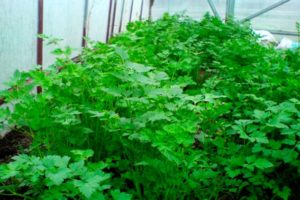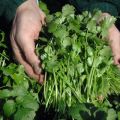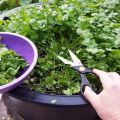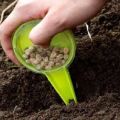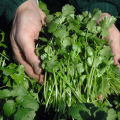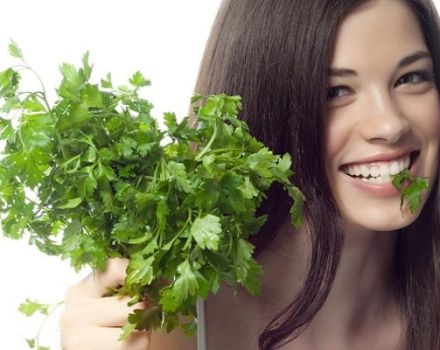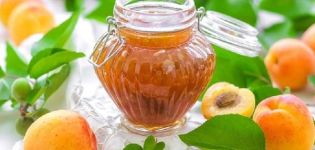Description of the coriander variety Amber, Borodinsky and Debut features of cultivation and care
The pleasant spicy scent of coriander cannot be confused with the scent of any other plant. Due to this, it occupies a special place among spices. But the most famous and popular among gardeners is Amber Coriander. Let us consider in more detail the features of this variety and recommendations for its cultivation.
Description of the variety
Coriander belongs to the annual plants of the Umbrella family. Its height can reach 75 cm. It is characteristic that the root has the shape of a spindle. Stems are rounded, branching from the very root. The cirrus-dissected leaves of the cilantro variety Amber are dark green in color.
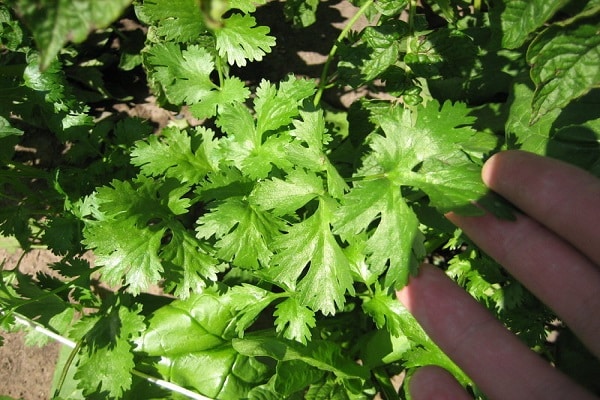
The flowers are white or pink. The flowering period of the plant begins in May and lasts until the end of July. Flowers are collected in a spreading umbrella.
In August, the fruits of the Amber coriander are fully ripe. They look like small beads with a diameter of no more than 0.5 mm. Their distinctive feature is that they have a pleasant rich spicy aroma.
In the wild, the plant is found in southern Russia, the Caucasus, Central Asia or the Crimea.
The plant is often grown in backyard or summer cottages in Ukraine, the Caucasus, and the European part of Russia.
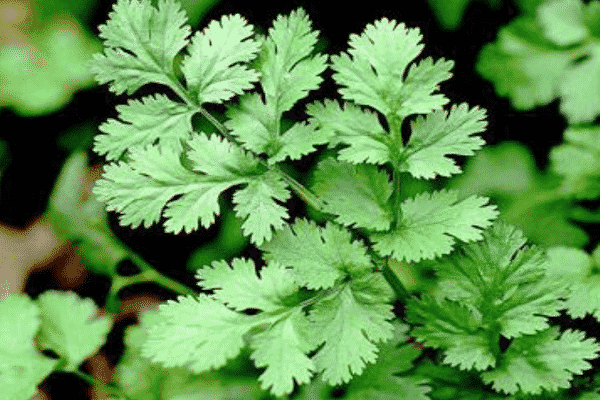
Greens are used in cooking for salads or other dishes. The seeds are simply irreplaceable in the preparation of marinades and sauces.
It is also impossible not to note the healing properties. For example, it is used for colds or diseases of the gastrointestinal tract. Periodic consumption of greens and seeds helps to improve visual acuity.
Similar varieties
The plant is valued primarily for the fact that it contains a large number of elements useful for human health:

- vitamins A, B, B2, C;
- carotene;
- starch;
- sugar;
- essential oils, etc.
There is a fairly large list of similar varieties.
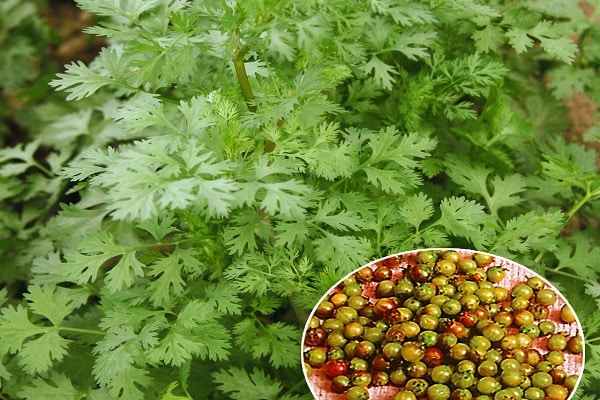
Borodinsky
The variety belongs to the mid-season. Greens are suitable for consumption within 45–50 days after the first shoots appear. The seeds ripen approximately 90–95 days after germination.
This variety reaches a height of no more than 75 cm. Its stems have an attractive spreading appearance. Borodinsky variety is able to withstand temperatures up to -1 degrees.
It is often used in medicine as a choleretic or pain reliever. By applying coriander greens to the wound, you can be sure that it will heal much faster.
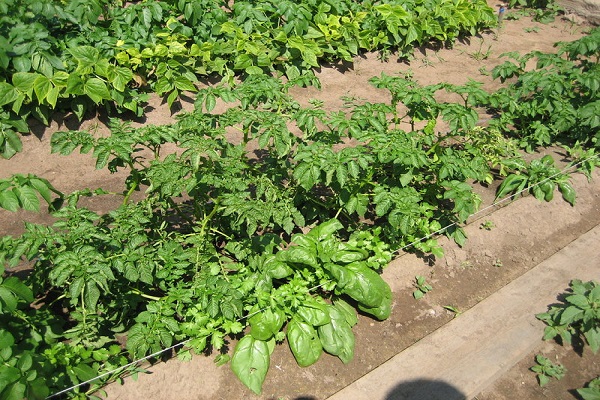
Debut
The plant of this variety fully ripens 30–40 days after the first shoots. The leaves have a pleasant green color and are collected in a rosette that rises slightly above the soil surface.
The height of this variety does not exceed 30 cm.The plant is rich in vitamins P, B2 and C.
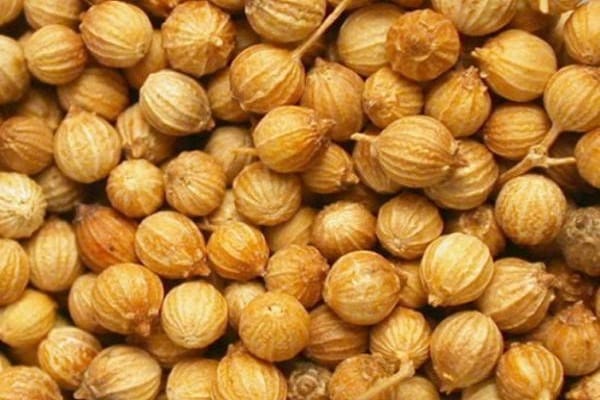
Stimulus
It's mid late cilantro variety... The plant fully matures only 100–120 days after the first shoots appear. Plant height is no more than 29 cm.
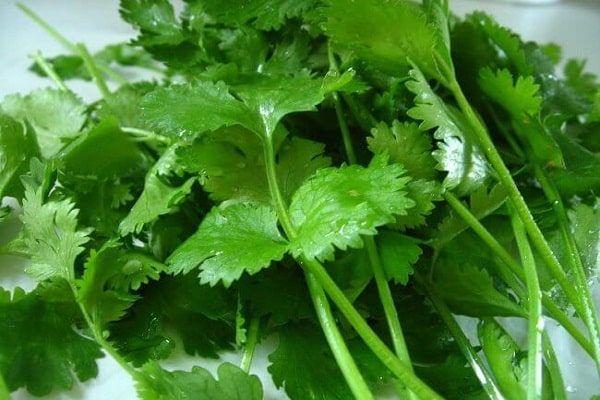
Venus
A distinctive feature of this variety of coriander is that it ripens quite late. The leaves are neatly collected in a socket raised above ground level.
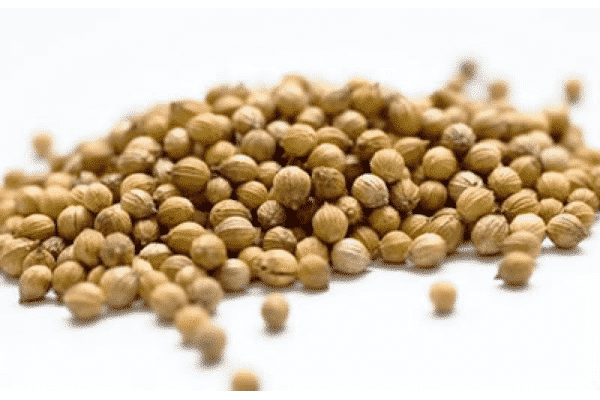
Caribe f1
The plant of this variety is also late-ripening. The bush has an attractive, neat and compact appearance.
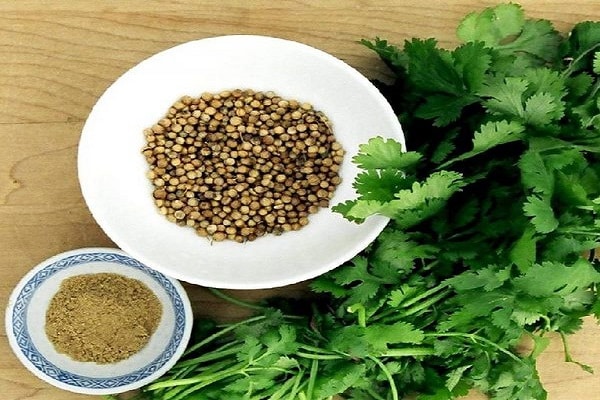
Growing
Despite the fact that the plant is considered exotic, it is quite easy to grow it. It is suitable for cultivation both in the open field and in greenhouses.
The place for growing cilantro must be sunny, without drafts.
It is better to prepare the soil on the site in the fall. To do this, a third of a bucket of humus mixed with 1 spoon of superphosphate or potassium sulfate fertilizer is applied to 1 square meter of soil. After that, the site is carefully dug up and leveled.
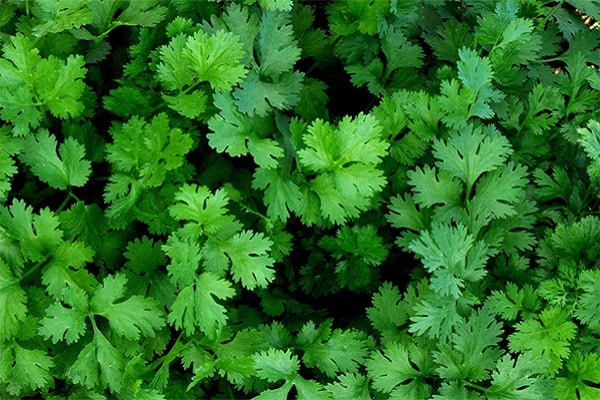
Before planting in the ground, it is recommended to add 1 spoon of urea. Seeds are sown in bulk (no more than 2.5–3 g of seeds are used per 1 square meter).
Due to the fact that the plant ripens rather quickly, up to 3 crops can be harvested in one season.
Coriander belongs to those plants that do not require special care. It consists only in timely watering, removing weeds and loosening the soil.
In order for the bushes to have branched greenery, experienced gardeners advise thinning cilantro shoots so that there is a distance of 9-10 cm between the rows. If the seedlings are not thinned out, it is possible that the plants will grow and develop slowly, their stems will be weak and not juicy.

If the soil under the plant is not watered in a timely manner, and it dries up, this will lead to the formation of early arrows. This significantly degrades the quality level of the finished product. When the seed ripens, it is better to stop watering the beds with cilantro.
Care features
The basis of agricultural technology is proper care of seedlings. The first rule, on the observance of which a good yield of Amber coriander depends, is to periodically moisturize the plants. It is considered optimal to water twice for 7 days. This process helps cilantro develop a thick and juicy green.
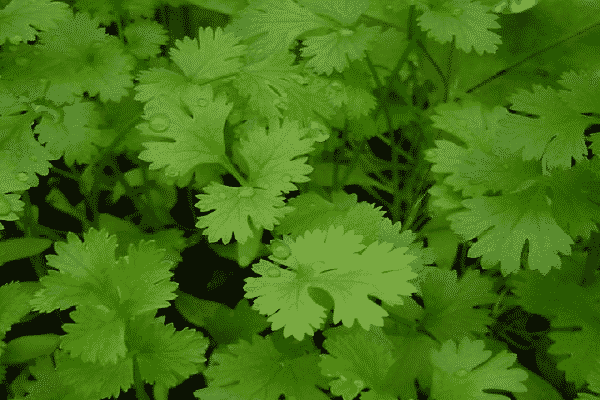
During the period of seed ripening, experts recommend watering plants no more than 1 time per week. If it is not possible to follow such recommendations, you can mulch the soil under them. This will keep moisture in the soil.
Since coriander is a light-loving plant, when choosing a place for planting it is necessary to choose well-lit areas.
When growing coriander Amber indoors, care is reduced to providing additional lighting, timely watering of the soil and moisturizing the plants.
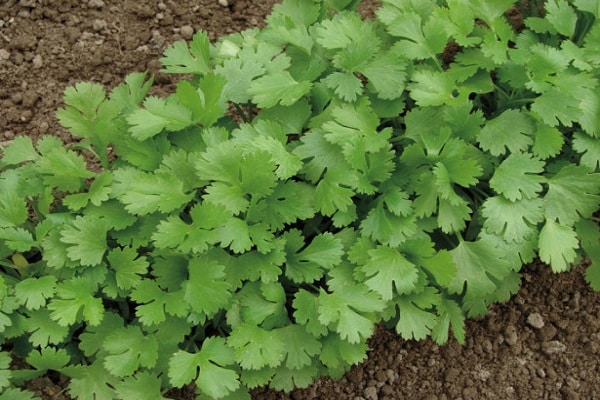
Advantages and disadvantages
This amazing plant has both many positive characteristics and disadvantages.
Among the advantages are the following:
- ease of cultivation and reproduction;
- the ability to use in cooking;
- the content of a large amount of useful components and vitamins;
- the ability to collect up to 3 crops per season;
- many medicinal properties of the plant.
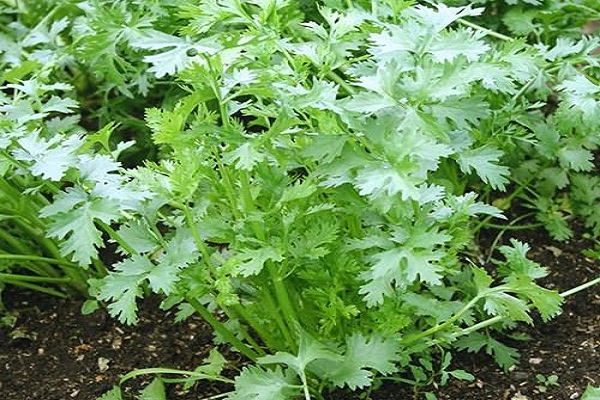
If we talk about the shortcomings, you should pay attention to the following:
- the presence of contraindications to the use of cilantro for people who have been diagnosed with an ulcer, gastritis, diseases of the cardiovascular system, high blood pressure or diabetes mellitus;
- with excessive use of spices, the possibility of a violation of potency in men is not excluded, and in women, the monthly cycle may be interrupted.
In order to avoid the manifestation of a negative reaction to grass, it is recommended to eat no more than 35-40 g of greens and up to 5 g of seeds per day.
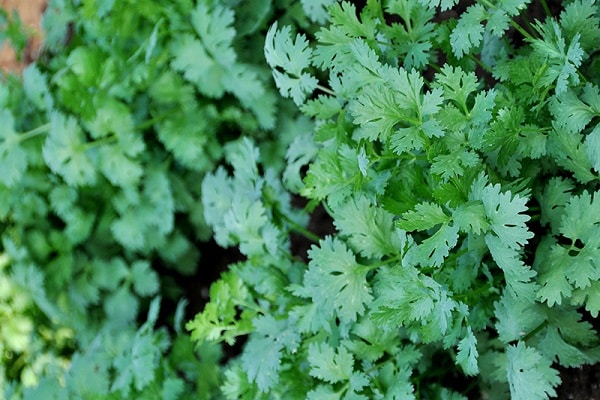
Pests and diseases
Like any plant that is cultivated on land, coriander Amber has its own pests, and it also tends to be subject to various diseases.
The most dangerous pests for grass are:
- Coriander seed. It feeds on the seeds of the plant, gnawing tiny holes in them. This can cause irreparable damage to the quantity of the crop and its quality. The seed eater lays its larvae inside the fruit, damaging their endoderm. One insect can damage up to 80% of the crop. In order to avoid the development of such an unpleasant situation, it is recommended to dress the seeds before sowing them. The soil in which it is planned to sow them must be thoroughly cleaned from the presence of plant residues.
- Bedbugs (striped and umbrella). Insects eat plants that are in the growing season.
- Winter scoop. The carriers of this pest are plants of the Umbrella family. After wintering on them, insects migrate to coriander and feed on its seeds.
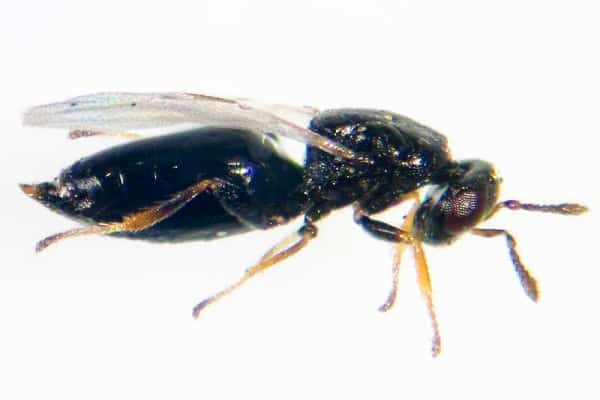
Among the most common diseases of amber coriander are the following:
- Ramulariasis. The development of this disease is facilitated by low summer temperatures, as well as strong and frequent dew on the soil surface. At the same time, rounded spots of a brownish color appear on the surface of the green part of the grass. Over time, a white coating appears on them. With a strong spread of ramulariasis, the plant dies.
- Rust. Symptoms and causes of development completely coincide with the previous disease.
- Powdery mildew. A powdery bloom and structure appears on the surface of leaves and stems.
To prevent the development of diseases before sowing seeds, it is recommended to dress them with special preparations.
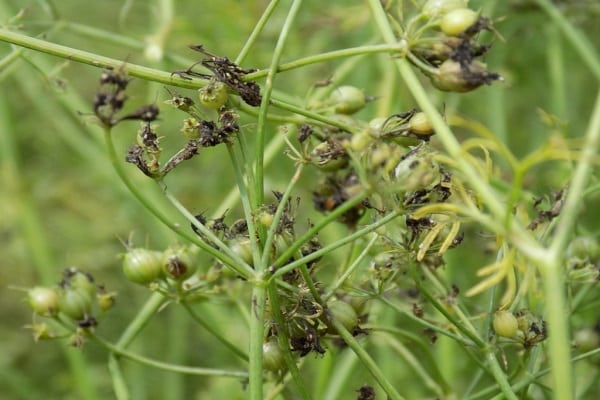
Harvesting and storage
The spice can be grown both for herbs and seeds. In order to get a good harvest, you need to know at what time it needs to be harvested.
When it comes to harvesting the green part of the grass, it is best to harvest it before the flowering period of the plant. When cut at a later time, the taste becomes rather unpleasant. The height of the greenery that goes under the cut should not exceed 13 cm.
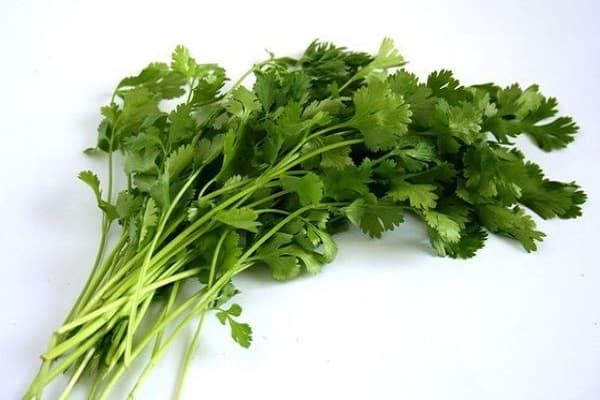
As for collecting seeds, the most favorable time for this is the period when they acquire a rich brown hue.
Greens can be consumed both fresh and dried. Dried leaves and stems must be stored in a dry and dark place at a temperature not exceeding 22 degrees.
Dried seeds placed in a tightly closed container can be stored for a long time without losing their unique aroma.
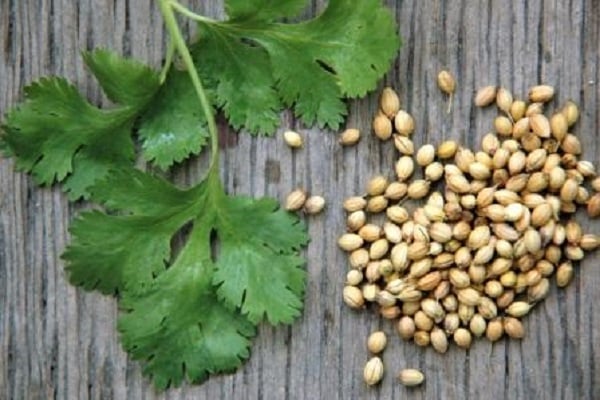
Cooking applications
The popularity of coriander amber among gardeners is due to the fact that it can be actively used in cooking.
This could be:
- marinade;
- sauce;
- ketchups;
- pea or bean soup;
- sandwiches;
- smoking;
- pilaf;
- kebab.
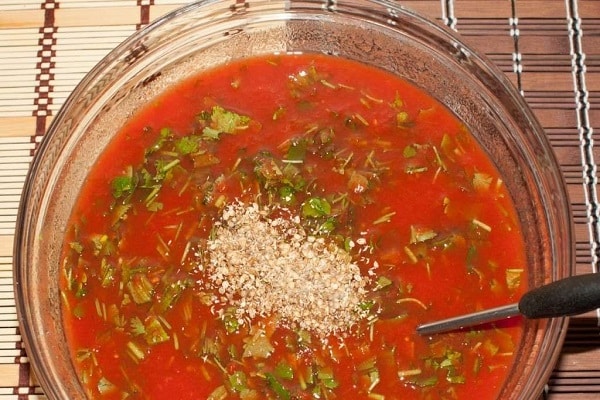
Before deciding to add coriander to the dish, you must not forget that it is used in small quantities. In addition, different parts of the plant taste differently.
Coriander Amber is a unique herb that has a unique aroma and taste. Even a novice gardener can grow it.
